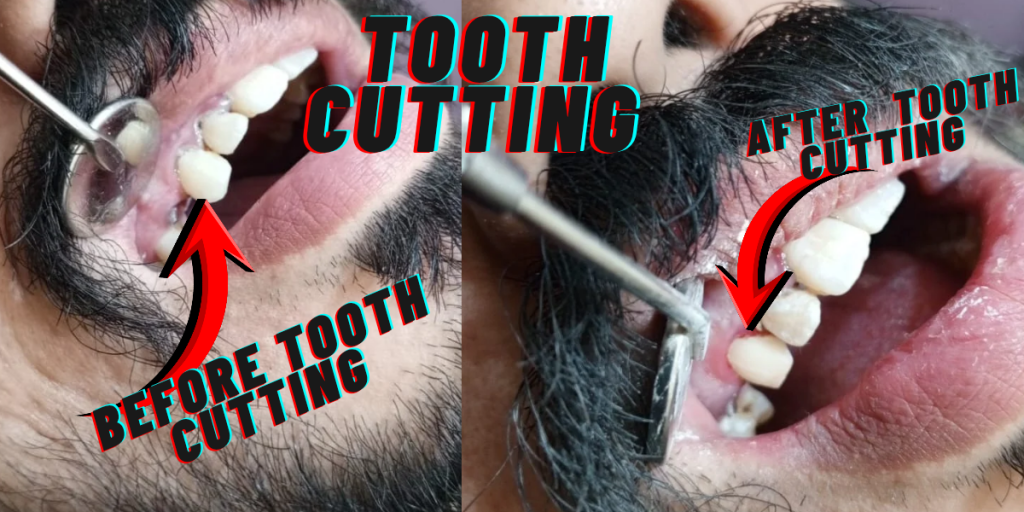Physical Address
304 North Cardinal St.
Dorchester Center, MA 02124
Physical Address
304 North Cardinal St.
Dorchester Center, MA 02124
Ever wondered what really happens to your tooth during that “cutting” phase in dental procedures like crowns or veneers, and how it transforms your smile afterward? Tooth cutting, or enamel reduction, is a key prep step where your dentist carefully shapes the tooth to make room for a custom restoration, turning a damaged or imperfect one into a strong, natural-looking powerhouse—without the drama you might imagine. Whether you’re facing decay, cracks, or cosmetic tweaks, this before-and-after journey eases worries by showing the seamless shift from vulnerable to vibrant. In this no-fluff guide, we’ll walk through what to expect at each stage, with tips to stay comfy and confident.

Before the Procedure: Getting Prepped
It all starts with a consult where your dentist checks the tooth with exams and X-rays to plan the best approach. They’ll discuss materials like porcelain for natural looks or zirconia for toughness, and numb the area with local anesthesia to keep things painless. Skip eating heavy meals beforehand if you’re anxious, and bring questions about recovery. This sets a solid foundation for a smooth process.
During the Cutting: The Main Event
Here, the dentist reshapes the tooth by trimming enamel—usually 1-2mm—to fit the crown snugly. It’s precise work using tools like burs, often under numbing so you feel pressure but no pain. They’ll clear any decay too. Impressions or digital scans follow to craft your restoration, wrapping up in about an hour. A temp crown protects the site until next time.
Right After Cutting: Immediate Changes
Post-prep, your tooth looks smaller and feels exposed, but the temporary covers it. Mild sensitivity to hot/cold is common as gums adjust, fading in days. Avoid chewy foods at first to not dislodge the temp. This phase bridges to the final fitting, where the real transformation shines.
The Long-Term After: Your New Normal
Once the permanent crown is placed (usually a week or two later), the tooth regains full strength and blends seamlessly. Before, it might’ve been weak or unsightly; after, it’s protected, with better bite and aesthetics. Crowns last 10-15 years with care—think regular brushing and check-ups. For veneers, the focus is more cosmetic, slimming the front surface.
Care Tips for a Smooth Transition
Post-procedure, rinse with saltwater for soothing, and use over-the-counter pain relievers if needed. Floss carefully around the crown, and wear a night guard if you grind. Watch for signs like persistent pain—call your dentist if that hits. Good habits extend the restoration’s life.
1.Before prepping for a crown, the tooth’s got its normal, everyday shape.
2.Some people show up with teeth all banged up from cavities or just breaking off.
3.Teeth start out with their natural shape, but to slap on a crown, we gotta trim it down on all four sides.
4.Once we’re done trimming, the tooth changes shape and ends up looking smaller.
5.After the cut, that outer enamel layer gets taken off.
6.Trimming the tooth can leave it feeling pretty sensitive.
7.With that sensitivity, some folks notice pain or weird feelings from hot and cold stuff.
8.If you’re dealing with pain or that hot-cold zing, we usually recommend a painkiller like Orno 8mg.
9.Right after the trim, we grab an impression of the tooth and send it to the lab to craft the crown.
Why This Procedure Matters
Tooth cutting isn’t just trimming—it’s rebuilding for durability. Before, risks like fractures loom; after, your smile’s fortified against daily wear. It’s common for crowns after root canals or large fillings, boosting confidence without major surgery.
FAQs About Tooth Cutting Procedure
Does it hurt during cutting?
With numbing, nope—just some vibration. Sensitivity after is mild and temporary.
How much tooth is cut?
About 1-2mm of enamel, depending on the restoration—enough for a secure fit without weakening the core.
What’s the difference before and after?
Before: Vulnerable to breaks or decay. After: Stronger, prettier, and functional like new.
Can I eat normally right after?
Stick to soft foods until numbness fades; full normalcy returns in a day or two.
Is it reversible?
Not really—enamel doesn’t regrow, but the crown protects what’s left long-term.
Wrapping up the before-and-after of a tooth cutting procedure, it’s all about that smart transformation—from a tooth that’s weak or worn to one that’s reinforced, sleek, and ready for action, giving you back a smile that’s both functional and fabulous without the fuss. Knowing what to expect turns the unknown into an exciting step toward better oral health, whether it’s prepping for a crown or veneer. If this peek has you feeling more prepared for your dental adventure, reach out to your dentist for the next move.